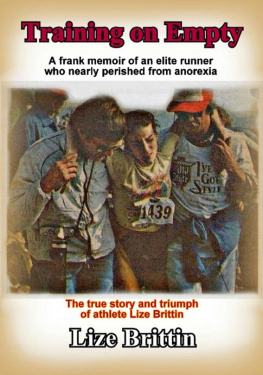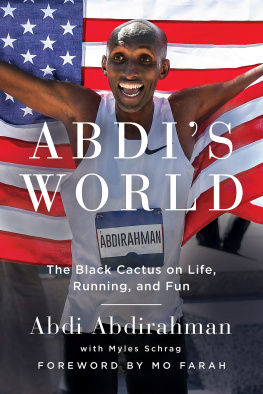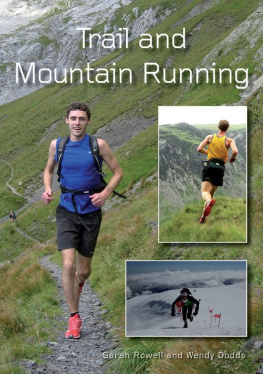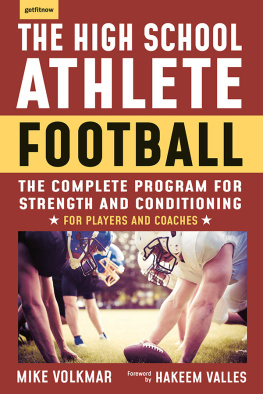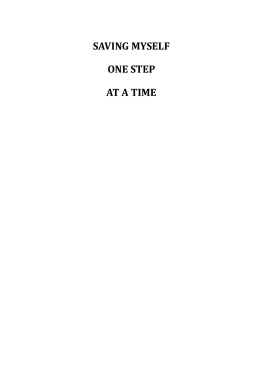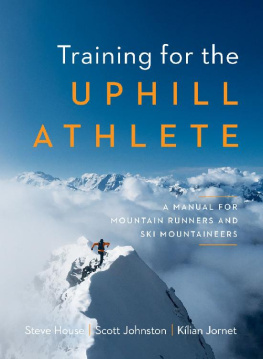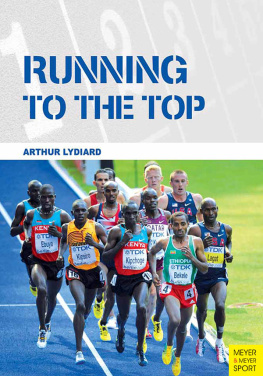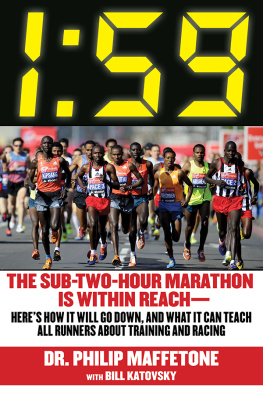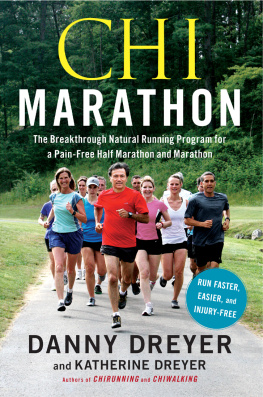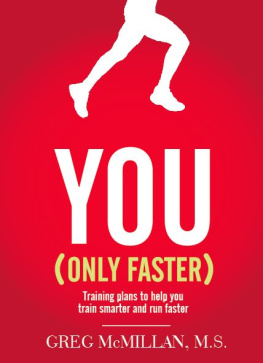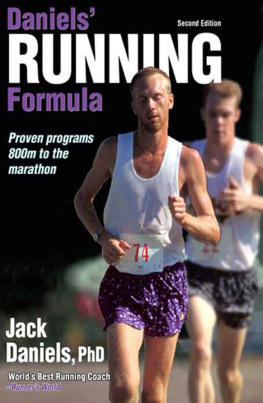Training on Empty
Lize Brittin
Copyright 2012 Lize Brittin
Published on Smashwords
Cover image: Dave Schreiber
Formatted by
* * *
All Rights Reserved.
No part of this publication may bereproduced, stored in a retrieval system, or transmitted, in anyform or by any means, without the prior permission in writing ofthe publisher, nor be otherwise circulated in any form of bindingor cover other than that in which it is published and without asimilar condition including this condition being imposed on thesubsequent purchaser.
First Edition License Notes
This e-book is licensed for your personalenjoyment only. This e-book may not be re-sold or given away toother people. If you would like to share this book with anotherperson, please purchase an additional copy for each person youshare it with. If you're reading this book and did not purchase it,or it was not purchased for your use only, then you should returnto Smashwords and purchase your own copy. Thank you for respectingthe author's work.
* * *
TABLE OFCONTENTS
* * *
Athletic competition is a heroic journey. Thelate scholar Joseph Campbell, himself an athlete, brilliantlydescribes the path of the hero in his book, Hero of a ThousandFaces. The seeker, in the quest for the fulfillment of a dream,ventures into the unknown. Whether the prize sought is as lofty asan Olympic gold medal or as modest as completing ones first 5krace it becomes in itself the representation of something ofgreater inherent value the process of personal transformationthat springs from accepting and loving a part of self thatpreviously remained in shadow. The excitement to go into newterritory soon leads one face to face with the limitations of thestatus quo once committed the onus is on the seeker to remakeher/himself or collapse into the hell of an unrealized life.
Recently I was a guest speaker at a WomensQuest Retreat, run by my colleague and lifelong friend ColleenCannon. The women that come to these week-long fitness adventuresare typically successful middle-class, self-aware, body-conscious,mothers, sisters and daughters. This evening I thought to ask howmany of them liked their bodies. I expected at least half. I wasshocked when of the 28 participants only 2 raised their hands.Interestingly enough those two hands did not rise from the young,sleek beauties, but from two of the senior women who had taken theheroic journey, perhaps many times. On the subject of their earthlyvehicle they had finally come to rest at a point of appreciation.The other women all wished for a physical composition other thanthe one they possessed.
The human body, male or female is anastonishing piece of machinery, which we are told is made in theimage of the Creator. You just cant get much better than that. Sowhat is this mantle of depreciation and deprecation that themajority of modern women don that makes them feel self-hatred attheir own image?
If we go way back we can see that ever sinceEve got blacklisted for giving Adam an apple, women have had a hardtime getting their rightful esteem throughout history. Couplingwith this undervaluation of the feminine is an overvaluation of themale attribute of aggression through the sustained misappropriationof youthful testosterone into acts of war. The masculine/femininerelationship remains polarized to this day, massively leaking theingredients of potential miracles.
While the see-saw of gender roles andresponsibilities greatly shifted in the 20th century this polarityremains. The car and TV as household items have ushered in thenuclear family for western civilization and we have hailed the pillas the liberation of women and the breakdown of sexual stereotypes.But there has been a trade-off. When women made the inroads intothe affairs of men the status of her biologically-mandated role asnurturer took a hit. Institutions took over the role ofgrandmothers, moved birth out of the hands of midwives into thesurgical units of hospitals, and separated babies from theirmothers after delivery. The symbol of Mother, the breast, wasdeemed inferior to the bottle; human milk inferior to a cows. Inthe 70s economics shunted women out of the home into the workforceen masse, and children into daycares. The family garden plot wentto high-rise condos and the source of food became a supermarket.Home-made soup alchemized with mothers loving hands has now beensupplanted with a plethora of pseudo-foods imbued with cold steeland a profit margin behind them. Consequently most westernsocieties suffer from a deficiency of the most basic building blockof physical and emotional development that sets us up for health,happiness and the fulfillment of our potential Mothering. We havebeen duped, and earthlings are in real trouble because of it.
Our fundament, Mother Earth, has slid to thebottom of totem pole. Her denunciation is a meme personalizedthrough the bodies of women a miserable slab of granite formedover eons, to which both genders are shackled. Anorexia, bulimia,fatness and thinness, the shrouding and mutilation of women,addiction to superficial forms of beauty, and myriad ways in whichwomen are debased, belong to us all. Sadly this issue has beenlargely cloaked with secrecy, and inadequately confined to therealm of the individual, rather than addressed collectively. Allthis brings me to a time where I encounter 26 out of 28 fit,healthy, modern women who are deeply ashamed of their bodies. Amongthem and behind them is a silent epidemic of girls and women livingin a land of unprecedented material supplies who do not even feelentitled to the essential right to feed themselves adequately.
The exploration of the athletic potential ofthe female body has and will continue to be a face-off with thisdense paradigm. Invariably it is one of those obstacles encounteredby any woman who undertakes the heroic journey in an athleticarena, as Lize Brittan did. A brilliant young athlete full of hopefor a top career, Lize hit the rock at full speed. It almost killedher. Lizes story is both heart-rending and inspiring. But moreimportantly her journey of self-discovery so candidly delivered andinterspersed with practical and meaningful guidance, offers aunique road-map of the eating-disorder territory, especially forathletic women. The dilemma of the act of running as both saviorand executioner is harrowing to read, as are her flirtations withdeath in an excruciating slow suicide attempt by starvation. Buteven in despair Lizes spark shines through with courage andintelligence. Her eventual apotheosis of learning to surrender tothe feminine deserves nothing short of a standing ovation.
With this fascinating and informative memoira big chunk of granite has been broken off, a womens soul restoredto life, and a call to others to take the heroic journey resounds.As a society the job is not done until the last piece of themonolith has been chipped away and transmuted into a new paradigmwhere the magnificence of our physicality, male and female, isfreely nurtured and expressed without apology.
Lorraine Moller
Olympic Marathon Bronze medalist
Author of On the Wings of Mercury
* * *
Despite my intensely reckless and veryunhealthy behavior, I am still alive. At my lowest point, I weighedless than 80 pounds at a height of five feet four inches. I washaving seizures and was in the beginning stages of complete organfailure. I was jaundiced. My pituitary gland wasnt functioningproperly. My hair was falling out, and my skin was scaly. I hadedema and was constantly thirsty. I looked like a concentrationcamp victim, yet I felt fat all the time. I had lost touch withreality. I was anorexic.
Anorexia is pardon the expression a heavytopic. For more than one reason, its not the kind of thing tobring up at the dinner table. Then again, how many anorexicsactually sit down to eat dinner? Its a sad, painful, scary anddestructive path that an anorexic takes-a path that the peoplearound her often end up being forced to travel as well.
Next page
